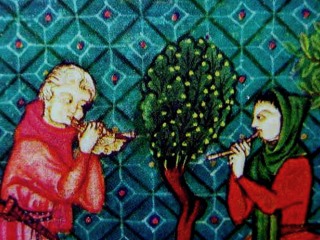

The albogues are a category of Spanish primitive musical wind instruments. A few of them belong to rural traditions that have survived until modern days. The main ones are: the Gaita Gastoreña in Cadiz (Andalusia), the Gaita Serrana in Madrid and the Alboka in the Basque Country and Navarre. One of their peculiarities is that the bell that amplifies the sound is made out of a large section of cow or goat horn. These Spanish albogues are equivalent to other ancient hornpipe instruments traditional in several places in Europe like: the Pibgorn (also Pibcorn or Piccorn) in Wales, the Stock-and-Horn in Scotland, the Lävikkö in Finland, or the Zhaleika in Russia.
Basic Description
These albogues (primitive clarinets may be a fair translation) have single reeds like the elements that generate the vibration of the air blown by the musician. The reeds are inserted in very simple cylindrical melody pipes (made out of a short piece of wood or cane), that have different numbers of finger holes depending on the specific albogue. The reed can be uncovered or protected by a short piece of cow or goat horn attached to the upper end of the melody pipe. The horn that becomes the amplifying sound bell is attached to the lower end of the melody pipe.
In the case of the Alboka, a common air blowing technique is by Circular Breathing. This is also used by players of some traditional wind instruments to produce a continuous sequence of tones without interruption, such as: the launeddas in Sardinia, the didgeridoo in Australia, but also the contemporary trumpets and horns. This is accomplished by breathing in through the nose while simultaneously blowing out through the mouth using air stored in the cheeks.
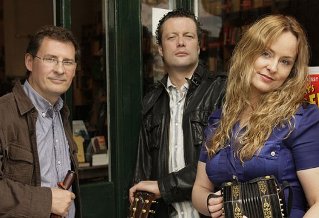
Such kind of instrument and playing technique, makes you think that the next natural evolution would be to get the upper end of an albogue plugged to a bag made out of animal skin, and the musician could blow air in the bag through a mouth piece. This will make the bag become the air reservoir, and thus alleviate the continuous effort made by the musician with his nose and cheeks. In this case we would have then ‘reinvented’ some of the most primitive kinds of bagpipes, by using these hornpipes as chanters. Traditional bagpipes of this kind would be: the Mezued (Algeria, Libya), the Mezonad (Tunis), the Tulum (Turkey), the Tsampouna or the Aski (Greece), the Sliviri (Georgia), the Dudy (Poland), the Bock (Bavaria, southern Germany), or the Rosca in Galicia (NW Spain).
The Origins
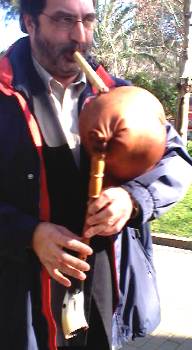
As for most other primitive musical instruments, the ancestors of all hornpipes (including these three Spanish albogues: Gaita Gastoreña, Gaita Serrana and Alboka) are probably dated in remote days of human history, and derived from the activities associated to peasantry and animal husbandry. In the case of the Basque ‘alboka’ and the generic name ‘albogue’ in Spanish, it is understood that they are related to the Arabic word "al-bûq" (البوق) (literally: "the trumpet" or "the horn").
The assumption is that these kinds of instruments were probably originally native to central Asia or the Middle East, and may have been brought into the Iberian peninsula (today’s Portugal and Spain) by the Arab conquest that started from the south of Spain in 711.
Did similar instruments already exist in the peninsula before the Arab invasion? Maybe, but it cannot be confirmed. What is clear is that these instruments have become well established in the country since the Middle Ages as represented in book illustrations and sculptural church decorations of that time. The word ‘albogue’ is mentioned in the ‘Poema de Alexandre’ (13th century poem about the life of Alexander The Great written in old Castilian language), in a paragraph describing some minstrels (juglares) playing different musical instruments (hurdy-gurdy, harp, rebec, crwth/crowd, psaltery, citola, viol, ...):
. . .
El pleyto de ioglares era fiera nota,
Auye hy simfonía, arpa, giga e rota,
Albogues e salterio, cítola que más trota,
Çedra e viola que las coytas enbota.
. . .
In the case of the Gaita Gastoreña or Serrana, the assumption of the medieval Arab ancestry is also valid. In fact, the Arab invasion of the Iberian peninsula (Spain and Portugal, from 711 until 1492) is usually considered a period of great influx of medieval musical instruments of all kinds (percussion, wind, strings), that were spread from the Middle East and the North of Africa into Southern Europe.
The Alboka
The peculiarity of the Basque Alboka when compared with the other Spanish albogues is that it has not one, but two melody pipes installed in parallel, each of them having a single reed. The number of parts of the Alboka and the way to assemble them together shows also some more complexity.
To get deeper knowledge of this instrument, I refer to an article by the Basque musician Ibon KOTERON, published in the Spanish printed magazine INTERFOLK (Issue No. 2, 1999). Most of the texts below are direct translations of this article.
The body of the Alboka consists of two cylindrical pipes (traditionally they were two pieces of cane although nowadays they can be also lathed on granadillo wood), each of them having a different number of holes (5 in the left pipe, 3 in the right pipe) and a single reed, and covered by a segment of cow horn which then becomes the mouth piece. These two pipes are then installed side by side on the straight edge of a piece of wood carved with semicircular shape called the ‘yugo’ (yoke), and each of them gets inserted a reed made out of a small piece of cane with a longitudinal rectangular cut.
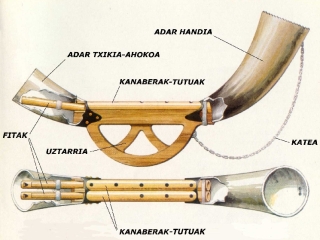
Two pieces of cow horn (the mouth piece and the sound bell) are cut and installed in such a way that they hold both ends of the melody pipes and the yoke together. In order to keep the whole assembly glued together and avoid any air leaks, all the joints are sealed with bee wax.
The scale of notes in today’s albokas is:
Some semitones can also be obtained by ‘half-closure’ of the holes.
The musician that played (and usually also built) the albokas was called ‘albokari’ or ‘albokero’ in Basque language (Euskera). One of the oldest and most famous traditional albokaris that played until recent times was Silvestre ELEZKANO a.k.a. ‘Txilibrin’, born in 1913 in the town of Igorre. Other prominent albokeros have been: Antonio AYESTA ‘Gitano’ (Bedia 1910 – Galdakao 1971), Jose María BILBAO (Artea 1886 – 1977), and his son León BILBAO (Artea 1916 – 1990).
Although it is assumed that the alboka was played in most parts of the Basque country (and even in the neighbour community of Navarre), the areas where the tradition of this instrument has been preserved the best is in the Arratia valley (province of Bizkaia), and also partially in the Aizkorri valley (Gipuzkoa province), although according to R.M. Azkue’s ‘Cancionero Popular Vasco’, the albokaris from Guipuzkoa had learned the tradition from the musicians from Arratia. That book from Azkue also mentions that even in the 1920’s the number of albokaris was relatively low. The fact is that in the latest decades there has been a very significant increase in the number of young musicians that have become interested in the recovery of the tradition for this instrument. Although it is true that differently than in the old days, the alboka has lost its function as the instrument for gatherings to dance traditional rhythms such as: jota, porrusalda or martxa. The percussion instrument that was usually played together with the alboka was the Basque tambourine: panderoa.
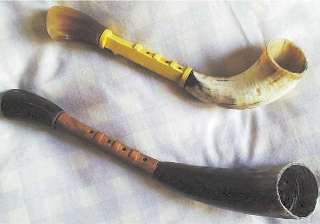
The name ALBOKA was also taken by a Basque folk band of the 1980s, whose albokari (and specialist on wind instruments in general) is the Irishman Alan GRIFFIN.
The Gaita Serrana
The generic name Gaita is mostly used in the languages of Spain and Portugal with the meaning of bagpipes: Galician, Asturian, Mirandesa, Zamorana, Scottish, Irish,... But it also used for several other kinds of popular musical instruments, mostly wind ones and even when such instruments do not have a bag as an air reservoir. This is the case of the Gaita Serrana, being an albogue of simpler construction than the above described Alboka.
The Gaita Serrana was very traditional until the 1940s in the northern end of the Sierra de Guadarrama, Spain’s central mountain range that becomes the north west border of Madrid’s province, with the neighbour community of Castilla y León. The last known municipalities in keeping the tradition for these instruments are the towns of El Berrueco and La Cabrera.
This albogue has a melodic pipe constructed from a piece of wood of squared section, having drilled the internal bore and up to 4 or 5 fingerholes. Its upper end has installed the single reed surrounded by the protective short piece of horn. Both the reed and the protective horn piece are removable. The bell of this clarinet is a large piece of cow horn attached and glued at the bottom of the melody pipe.
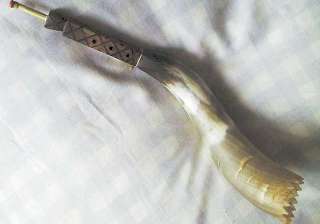
The Gaita Gastoreña
This albogue is similar to the above Gaita Serrana from Madrid’s mountains, but this one is traditional in the Sierra del Gastor (province of Cadiz), in the southern Spanish community of Andalusia. The melody pipe is also of squared cross sectional shape and has 3 holes on the front side and one on the back side. The bell consists in a long piece of cow or goat horn. Historical records about the tradition of this instrument mention that they were mostly played around the winter time (November and December).
Other kinds of Albogues in Spain
Although this kind of primitive wind instruments was probably used centuries ago in many other rural areas in Spain and Portugal, in many cases they had became extinct after the arrival of more evolved horns and oboes developed in subsequent historical periods.
There are a few other kinds of primitive traditional albogues still being manufactured and played in rural areas, such as:
The albogues are instruments with a very interesting and ancient history, but with limited musical possibilities when compared to other traditional clarinets or oboes of more evolved design (such as the Spanish Dulzainas or the French Bombardes). Therefore, there are not too many books specifically dedicated to them. Nevertheless, there are many texts and articles that can be found in a number of books, specialised magazines, music records and internet pages. Just a few of them are mentioned in the texts below (most of them written in Spanish, and a few of them in Basque language).
There are several descriptions about this kind of hornpipes in Wikipedia (in English) such as:
There is an important institution in central Spain (more precisely in the community of Castilla y León) dedicated to the study of the traditions and folklore of this region. This is the FUNDACIÓN JOAQUÍN DIAZ. The web page of its ‘Revista de Folkore’ contains extensive articles about the albogues:
Luis Angel PAYNO is a traditional instrument maker living in Madrid, that has compiled lots of information about the manufacturing of many instruments on his web page. In relation to the Spanish albogues, his page displays information about:
There is also interesting information specifically dedicated to the Basque alboka in:
My gratitude to Luis Angel PAYNO – RODRÍGUEZ for his expert advice for this article.
Photo Credits: (1) Albogues in King Alfonso X’s book ‘Cantigas de Santa María’ (14th century); (2) THE BASQUE-IRISH CONNECTION: Ibon KOTERON, Gavin RALSTON & Niamh NÍ CHARRA; (3) Luis PAYNO playing a Galician Rosca bagpipe built by Pablo CARPINTERO; (4) Alboka, Basque Country; (5) GAITA SERRANA, Madrid; (6) GAITA GASTOREÑA, El Gastor, Cádiz, Andalusia.